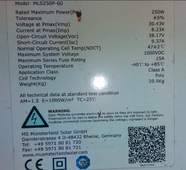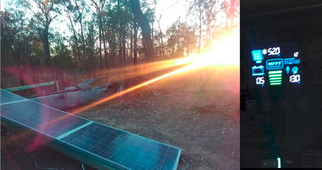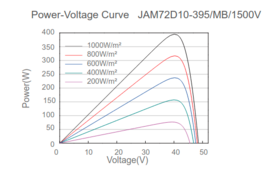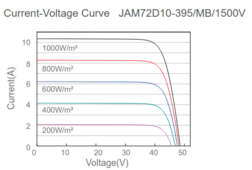Back story:
My system is two strings of 410w bifacial panels, each string is 2 panels in series, each string(was) feeding it's own LV2424 AIO. I'd planned to tilt the panel strings in opposite directions, hence the two two strings on separate MPPTs. Turns out I wasn't doing that, the panels stay on the same plane all the time. Frequently here in the PNW, we have enough light to kick on the MPPTs, but not enough to harvest power from, and during those times I'm just burning power to keep the MPPTs active. Each MPPT is rated at 2kw, one would handle the full output of all four panels, so I paralled both strings and fed them into one MPPT to save from burning power keeping the second MPPT active in low light conditions.
Immediately before paralleling the panels, I was bringing in ~300w per MPPT, 600w total. After doing so, that bumped up to over 800w with the same panels, and stayed there for a long time. Paralleling the strings took two minutes, and I was drawing ~2600w from the system, so battery state of charge wasn't a factor. I wish I had a light meter to take actual measurements instead of "welp, it looked the same brightness and cloud cover outside".
Question:
Are MPPTs known to be more efficient or effective when paneled at the higher end of their input, vs. the lower end? Is the 30% increase in power harvested due to a known phenomenon? I'm leaning towards eye witness evidence being the least reliable form of evidence, my eyes are not light meters, and if I got more power it's because there was more light.
Right now, light conditions are very low. Normally I'd be burning ~20w keeping the MPPTs active alone. Instead the paralleled strings are bringing in 16w. A pittance, but it's a gain instead of a loss, and I'll take it.
My system is two strings of 410w bifacial panels, each string is 2 panels in series, each string(was) feeding it's own LV2424 AIO. I'd planned to tilt the panel strings in opposite directions, hence the two two strings on separate MPPTs. Turns out I wasn't doing that, the panels stay on the same plane all the time. Frequently here in the PNW, we have enough light to kick on the MPPTs, but not enough to harvest power from, and during those times I'm just burning power to keep the MPPTs active. Each MPPT is rated at 2kw, one would handle the full output of all four panels, so I paralled both strings and fed them into one MPPT to save from burning power keeping the second MPPT active in low light conditions.
Immediately before paralleling the panels, I was bringing in ~300w per MPPT, 600w total. After doing so, that bumped up to over 800w with the same panels, and stayed there for a long time. Paralleling the strings took two minutes, and I was drawing ~2600w from the system, so battery state of charge wasn't a factor. I wish I had a light meter to take actual measurements instead of "welp, it looked the same brightness and cloud cover outside".
Question:
Are MPPTs known to be more efficient or effective when paneled at the higher end of their input, vs. the lower end? Is the 30% increase in power harvested due to a known phenomenon? I'm leaning towards eye witness evidence being the least reliable form of evidence, my eyes are not light meters, and if I got more power it's because there was more light.
Right now, light conditions are very low. Normally I'd be burning ~20w keeping the MPPTs active alone. Instead the paralleled strings are bringing in 16w. A pittance, but it's a gain instead of a loss, and I'll take it.









